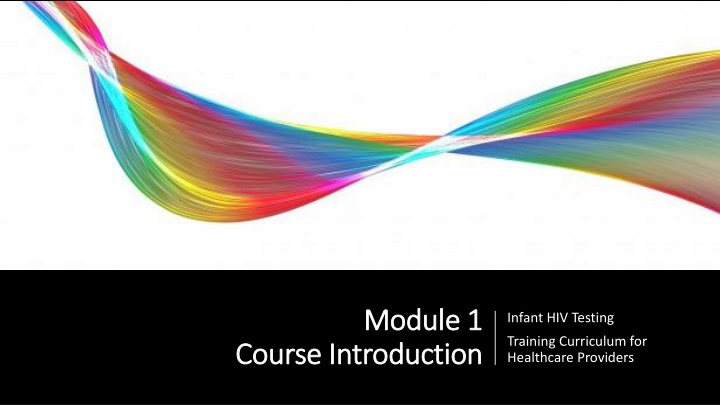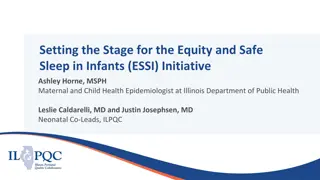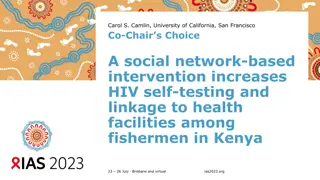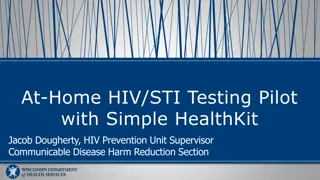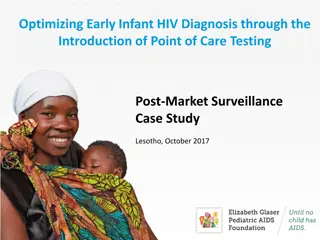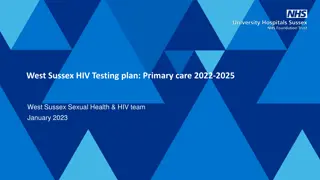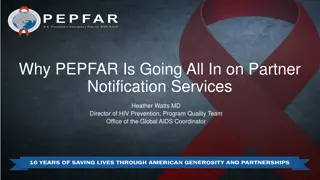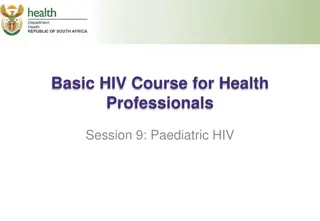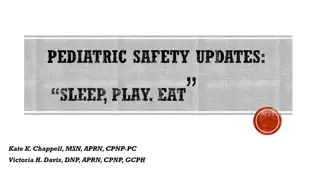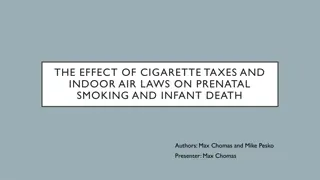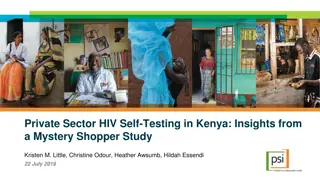Infant HIV Testing Training Curriculum: Overview and Objectives
This course provides healthcare providers with essential training on infant HIV testing, including interactive sessions, practical exercises, and core competencies. Participants will engage in discussions, reflections, and skill-building activities to enhance their understanding and skills in caring for HIV-exposed infants and supporting their families.
Download Presentation

Please find below an Image/Link to download the presentation.
The content on the website is provided AS IS for your information and personal use only. It may not be sold, licensed, or shared on other websites without obtaining consent from the author.If you encounter any issues during the download, it is possible that the publisher has removed the file from their server.
You are allowed to download the files provided on this website for personal or commercial use, subject to the condition that they are used lawfully. All files are the property of their respective owners.
The content on the website is provided AS IS for your information and personal use only. It may not be sold, licensed, or shared on other websites without obtaining consent from the author.
E N D
Presentation Transcript
Module 1 Module 1 Infant HIV Testing Training Curriculum for Healthcare Providers Course Introduction Course Introduction
Session 1.1 Session 1.1 Welcome and Introductory Activity Welcome and Introductory Activity Session Objectives During this session, participants will: Introduce themselves and be introduced to the trainer(s) Discuss expectations for the training
Exercise 1 Exercise 1 Getting to know each other: Large group discussion and individual reflection
Exercise 1, Individual Reflection Exercise 1, Individual Reflection Strengths: What is 1 personal strength that helps you or will help you work effectively with parents and their HIV-exposed infants? Concerns: What concerns or worries do you have about providing care to parents and HIV- exposed infants? Expectations: What do you hope to learn during this training course?
Session 1.2 Session 1.2 Training Objectives, Agenda, and Ground Rules Training Objectives, Agenda, and Ground Rules Session Objectives During this session, participants will: Gain an understanding of the training objectives Review the training agenda Establish training ground rules
Core Competencies Core Competencies See Appendix 6A: Practicum Checklist in Module 6 of your Participant Manuals
Agenda, 5 Agenda, 5- -day day Curriciulum Curriciulum 3.5 days in classroom followed by a 1.5 day practicum Modules: Module 1: Course Introduction Module 2: Testing of HIV-exposed Infants Module 3: Comprehensive Care for HIV-exposed Infants Module 4: Pre-test Information and DBS Collection for Infant Virological Testing Module 5: Post-test Counselling for Infant HIV Testing Module 6: Course Summary, Practicum and Wrap Up
Exercise 2 Exercise 2 Setting ground rules and introducing daily activities: Large group discussion Ground Rules Anonymous Question Bowl Morning Rounds How Did it Go?
Session 1.3 Session 1.3 Training Pre Training Pre- -Test Test Session Objective During this session, participants will: Complete the training pre-test
Session 1.4: Session 1.4: Paediatric HIV Overview: Paediatric HIV Overview: Global Progress and Goals Global Progress and Goals Session Objectives Discuss the status of HIV infections in children Discuss approaches and programmatic interventions to reduce mother-to-child HIV transmission Discuss approaches and programmatic interventions to ensure that children who are HIV-infected are rapidly identified and initiated on antiretroviral therapy (ART)
Children and HIV: Where We Are Now Children and HIV: Where We Are Now New diagnoses in infants and children have fallen dramatically with the scale up of PMTCT services However, infants and children are still becoming HIV- infected In 2018: 160,000 children age 0 14 years (down from 423,000 in 2000) became infected with HIV 1.7 million children were living with HIV 100,000 children died of HIV-related causes
HIV Epidemic Today HIV Epidemic Today Since the beginning of the epidemic to the end of 2018: 74.9 million people have been infected with HIV 32 million people have died of HIV. As of the end of 2018: 37.9 million adults were living with HIV In 2018 alone, about 770,000 people died of an AIDS-related illness* Sub-Saharan Africa remains most severely affected, with nearly 1 in every 25 adults (4.2%) living with HIV Nearly two-thirds of the people living with HIV worldwide, live in Sub- Saharan Africa** *UNAIDS. Global HIV & AIDS statistics 2019 fact sheet. **WHO. Global Health Observatory Data: HIV/AIDS 2017.
Sustainable Development Goals Sustainable Development Goals The HIV/AIDS, TB, malaria and other related child- and adult-health goals were replaced by one overarching health goal: Goal 3 Ensure healthy lives and promote wellbeing for all at all ages. This new goal includes: By 2030, end the AIDS epidemic By 2030, ensure universal access to sexual and reproductive health- care services Support the research and development of vaccines and medicines Substantially increase health financing and the recruitment, development, training and retention of the health workforce
Global Progress in Reducing HIV Infection in Global Progress in Reducing HIV Infection in Children Children MTCT is almost entirely preventable where services are accessible and utilized. Since 2010 there has been a 41% decline in new HIV infections among children PMTCT services have reduced MTCT rates: From 30 45% in breastfeeding populations To less than 2% in some countries.
Global Progress in Reducing HIV Infection in Global Progress in Reducing HIV Infection in Children Children Infants who are HIV-infected are at high risk for disease progression in the first year of life. Without treatment, 1/3rdof infants with HIV die before they one year of age Over 50% die by 2 years It is critical to initiate HIV-infected infants on ART as early as possible The key to early access to treatment is early diagnosis, highlighting the importance of: Testing HIV-exposed infants as early as possible Testing HIV-exposed infants regularly according to national algorithm until final HIV status determination at end of breastfeeding
Areas for Improvement Infant HIV testing: In 2018 only 54.9% of HIV-exposed infants were tested for HIV within the first 2 months of life* Even fewer are retained in care and tested at 18 months of age or after the end of breastfeeding Paediatric HIV diagnosis and provision of ART: Only 54% of the 1.7 million children living with HIV around the world received ART** *UNICEF. UNICEF Data. Global and Regional Trends. July 2019. **UNAIDS. Global HIV & AIDS statistics 2019 fact sheet.
Exercise 3 Large group discussion about HIV in infants and children What do you think needs to be done to reduce the number of children infected with HIV? What do you think needs to be done to lower the infant and child death rate from HIV?
Module 1: Key Points Module 1: Key Points This module provided an opportunity for participants to articulate their strengths, concerns about providing testing and care to HIV- exposed infants, and expectations of this training. Participants should now have a clear idea of what to expect from the training and hopefully are getting to know their fellow trainees.
Module 1: Key Points Module 1: Key Points In order to meet development goals and improve the lives of children, it is critical that countries strengthen PMTCT programs, improve the coverage of infant HIV testing services, support comprehensive care for HIV-exposed infants, and ensure that infants diagnosed with HIV are provided with the HIV-related treatment that they need, including ART.
Credits Strength icon by Ben Davis from the Noun Project Concern icon by Adrien Coquet from the Noun Project Agenda icon by Mark Shorter from the Noun Project Question icon by Aneeque Ahmed from the Noun Project Aids icon by rivercon from the Noun Project Pregnancy and AIDS icon by Andrei Yushchenko from the Noun Project Chart improvement icon by Saeful Muslim from the Noun Project
